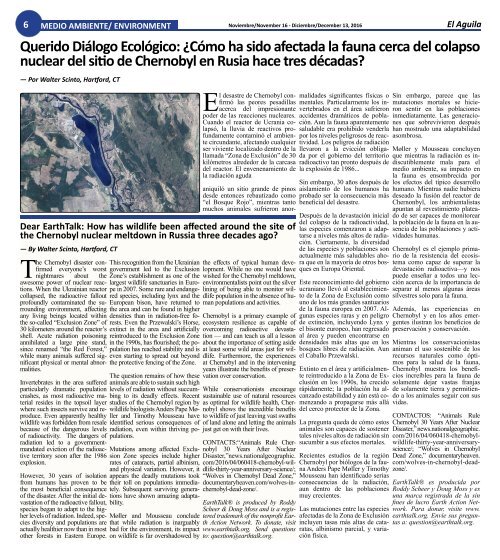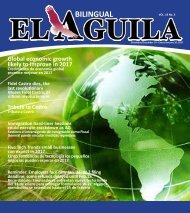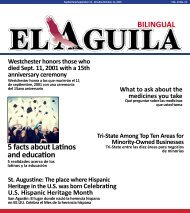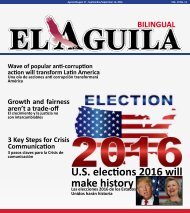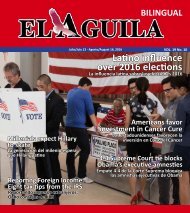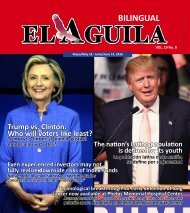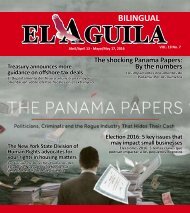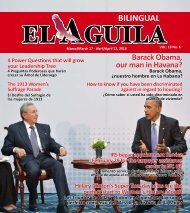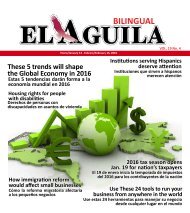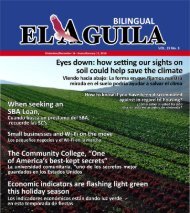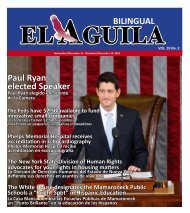El Aguila Magazine – November 16, 2016
You also want an ePaper? Increase the reach of your titles
YUMPU automatically turns print PDFs into web optimized ePapers that Google loves.
6 MEDIO AMBIENTE/ ENVIRONMENT Noviembre/<strong>November</strong> <strong>16</strong> - Diciembre/December 13, 20<strong>16</strong> <strong>El</strong> <strong>Aguila</strong><br />
Querido Diálogo Ecológico: ¿Cómo ha sido afectada la fauna cerca del colapso<br />
nuclear del sitio de Chernobyl en Rusia hace tres décadas?<br />
— Por Walter Scinto, Hartford, CT<br />
Dear EarthTalk: How has wildlife been affected around the site of<br />
the Chernobyl nuclear meltdown in Russia three decades ago?<br />
— By Walter Scinto, Hartford, CT<br />
The Chernobyl disaster confirmed<br />
everyone’s worst<br />
nightmares about the<br />
awesome power of nuclear reactions.<br />
When the Ukrainian reactor<br />
collapsed, the radioactive fallout<br />
profoundly contaminated the surrounding<br />
environment, affecting<br />
any living beings located within<br />
the so-called “Exclusion Zone” of<br />
30 kilometers around the reactor’s<br />
shell. Acute radiation poisoning<br />
annihilated a large pine stand,<br />
since renamed “the Red Forest,”<br />
while many animals suffered significant<br />
physical or mental abnormalities.<br />
Invertebrates in the area suffered<br />
particularly dramatic population<br />
crashes, as most radioactive material<br />
resides in the topsoil layer<br />
where such insects survive and reproduce.<br />
Even apparently healthy<br />
wildlife was forbidden from resale<br />
because of the dangerous levels<br />
of radioactivity. The dangers of<br />
radiation led to a governmentmandated<br />
eviction of the radioactive<br />
territory soon after the 1986<br />
explosion.<br />
However, 30 years of isolation<br />
from humans has proven to be<br />
the most beneficial consequence<br />
of the disaster. After the initial devastation<br />
of the radioactive fallout,<br />
species began to adapt to the higher<br />
levels of radiation. Indeed, species<br />
diversity and populations are<br />
actually healthier now than in most<br />
other forests in Eastern Europe.<br />
This recognition from the Ukrainian<br />
government led to the Exclusion<br />
Zone’s establishment as one of the<br />
largest wildlife sanctuaries in Europe<br />
in 2007. Some rare and endangered<br />
species, including lynx and the<br />
European bison, have returned to<br />
the area and can be found in higher<br />
densities than in radiation-free forests.<br />
Even the Przewalski’s Horse,<br />
extinct in the area and artificially<br />
reintroduced to the Exclusion Zone<br />
in the 1990s, has flourished; the population<br />
has reached stability and is<br />
even starting to spread out beyond<br />
the protective fencing of the Zone.<br />
The question remains of how these<br />
animals are able to sustain such high<br />
levels of radiation without succumbing<br />
to its deadly effects. Recent<br />
studies of the Chernobyl region by<br />
wildlife biologists Anders Pape Møller<br />
and Timothy Mousseau have<br />
identified serious consequences of<br />
radiation, even within thriving populations.<br />
Mutations among affected Exclusion<br />
Zone species include higher<br />
rates of cataracts, partial albinism,<br />
and physical variation. However, it<br />
appears the deadly mutations took<br />
their toll on populations immediately.<br />
Subsequent surviving generations<br />
have shown amazing adaptability.<br />
Møller and Mousseau conclude<br />
that while radiation is inarguably<br />
bad for the environment, its impact<br />
on wildlife is far overshadowed by<br />
<strong>El</strong> desastre de Chernobyl confirmó<br />
las peores pesadillas<br />
acerca del impresionante<br />
poder de las reacciones nucleares.<br />
Cuando el reactor de Ucrania colapsó,<br />
la lluvia de reactivos profundamente<br />
contaminó el ambiente<br />
circundante, afectando cualquier<br />
ser viviente localizado dentro de la<br />
llamada “Zona de Exclusión” de 30<br />
kilómetros alrededor de la carcasa<br />
del reactor. <strong>El</strong> envenenamiento de<br />
la radiación aguda<br />
aniquiló un sitio grande de pinos<br />
desde entonces rebautizado como<br />
“el Bosque Rojo”, mientras tanto<br />
muchos animales sufrieron anorthe<br />
effects of typical human development.<br />
While no one would have<br />
wished for the Chernobyl meltdown,<br />
environmentalists point out the silver<br />
lining of being able to monitor wildlife<br />
population in the absence of human<br />
populations and activities.<br />
Chernobyl is a primary example of<br />
ecosystem resilience as capable of<br />
overcoming radioactive devastation<br />
— and can teach us all a lesson<br />
about the importance of setting aside<br />
at least some wild areas just for wildlife.<br />
Furthermore, the experiences<br />
at Chernobyl and in the intervening<br />
years illustrate the benefits of preservation<br />
over conservation.<br />
While conservationists encourage<br />
sustainable use of natural resources<br />
as optimal for wildlife health, Chernobyl<br />
shows the incredible benefits<br />
to wildlife of just leaving vast swaths<br />
of land alone and letting the animals<br />
just get on with their lives.<br />
CONTACTS:“Animals Rule Chernobyl<br />
30 Years After Nuclear<br />
Disaster,”news.nationalgeographic.<br />
com/20<strong>16</strong>/04/060418-chernobyl-wildlife-thirty-year-anniversary-science/;<br />
“Wolves in Chernobyl Dead Zone,”<br />
documentaryheaven.com/wolves-inchernobyl-dead-zone/.<br />
EarthTalk® is produced by Roddy<br />
Scheer & Doug Moss and is a registered<br />
trademark of the nonprofit Earth<br />
Action Network. To donate, visit<br />
www.earthtalk.org. Send questions<br />
to: question@earthtalk.org.<br />
malidades significantes físicas o<br />
mentales. Particularmente los invertebrados<br />
en el área sufrieron<br />
accidentes dramáticos de población.<br />
Aun la fauna aparentemente<br />
saludable era prohibido venderla<br />
por los niveles peligrosos de reactividad.<br />
Los peligros de radiación<br />
llevaron a la evicción obligada<br />
por el gobierno del territorio<br />
radioactivo tan pronto después de<br />
la explosión de 1986...<br />
Sin embargo, 30 años después de<br />
aislamiento de los humanos ha<br />
probado ser la consecuencia más<br />
beneficial del desastre.<br />
Después de la devastación inicial<br />
del colapso de la radioactividad,<br />
las especies comenzaron a adaptarse<br />
a niveles más altos de radiación.<br />
Ciertamente, la diversidad<br />
de las especies y poblaciones son<br />
actualmente más saludables ahora<br />
que en la mayoría de otros bosques<br />
en Europa Oriental.<br />
Este reconocimiento del gobierno<br />
ucraniano llevó al establecimiento<br />
de la Zona de Exclusión como<br />
uno de los más grandes santuarios<br />
de la fauna europea en 2007. Algunas<br />
especies raras y en peligro<br />
de extinción, incluyendo Lynx y<br />
el bisonte europeo, han regresado<br />
al área y pueden encontrarse en<br />
densidades más altas que en los<br />
bosques libres de radiación. Aun<br />
el Caballo Przewalski.<br />
Extinto en el área y artificialmente<br />
reintroducido a la Zona de Exclusión<br />
en los 1990s, ha crecido<br />
rápidamente; la población ha alcanzado<br />
estabilidad y aún está comenzando<br />
a propagarse más allá<br />
del cerco protector de la Zona.<br />
La pregunta queda de cómo estos<br />
animales son capaces de sostener<br />
tales niveles altos de radiación sin<br />
sucumbir a sus efectos mortales.<br />
Recientes estudios de la región<br />
Chernobyl por biólogos de la fauna<br />
Anders Pape Møller y Timothy<br />
Mousseau han identificado serias<br />
consecuencias de la radiación,<br />
aun dentro de las poblaciones<br />
muy crecientes.<br />
Las mutaciones entre las especies<br />
afectadas de la Zona de Exclusión<br />
incluyen tasas más altas de cataratas,<br />
albinismo parcial, y variación<br />
física.<br />
Sin embargo, parece que las<br />
mutaciones mortales se hicieron<br />
sentir en las poblaciones<br />
inmediatamente. Las generaciones<br />
que sobrevivieron después<br />
han mostrado una adaptabilidad<br />
asombrosa.<br />
Møller y Mousseau concluyen<br />
que mientras la radiación es indiscutiblemente<br />
mala para el<br />
medio ambiente, su impacto en<br />
la fauna es ensombrecida por<br />
los efectos del típico desarrollo<br />
humano. Mientras nadie hubiera<br />
deseado la fusión del reactor de<br />
Chernonbyl, los ambientalistas<br />
apuntan al revestimiento plateado<br />
de ser capaces de monitorear<br />
la población de la fauna en la ausencia<br />
de las poblaciones y actividades<br />
humanas.<br />
Chernobyl es el ejemplo primario<br />
de la resistencia del ecosistema<br />
como capaz de superar la<br />
devastación radioactiva—y nos<br />
puede enseñar a todos una lección<br />
acerca de la importancia de<br />
separar al menos algunas áreas<br />
silvestres solo para la fauna.<br />
Además, las experiencias en<br />
Chernobyl y en los años emergentes<br />
ilustran los beneficios de<br />
preservación y conservación.<br />
Mientras los conservacionistas<br />
animan el uso sostenible de los<br />
recursos naturales como óptimos<br />
para la salud de la fauna,<br />
Chernobyl muestra los beneficios<br />
increíbles para la fauna de<br />
solamente dejar vastas franjas<br />
de solamente tierra y permitiendo<br />
a los animales seguir con sus<br />
vidas.<br />
CONTACTOS: “Animals Rule<br />
Chernobyl 30 Years After Nuclear<br />
Disaster,” news.nationalgeographic.<br />
com/20<strong>16</strong>/04/060418-chernobylwildlife-thirty-year-anniversaryscience/;<br />
“Wolves in Chernobyl<br />
Dead Zone,” documentaryheaven.<br />
com/wolves-in-chernobyl-deadzone/.<br />
EarthTalk® es producida por<br />
Roddy Scheer y Doug Moss y es<br />
una marca registrada de la sin<br />
fines de lucro Earth Action Network.<br />
Para donar, visite www.<br />
earthtalk.org. Envíe sus preguntas<br />
a: question@earthtalk.org.


